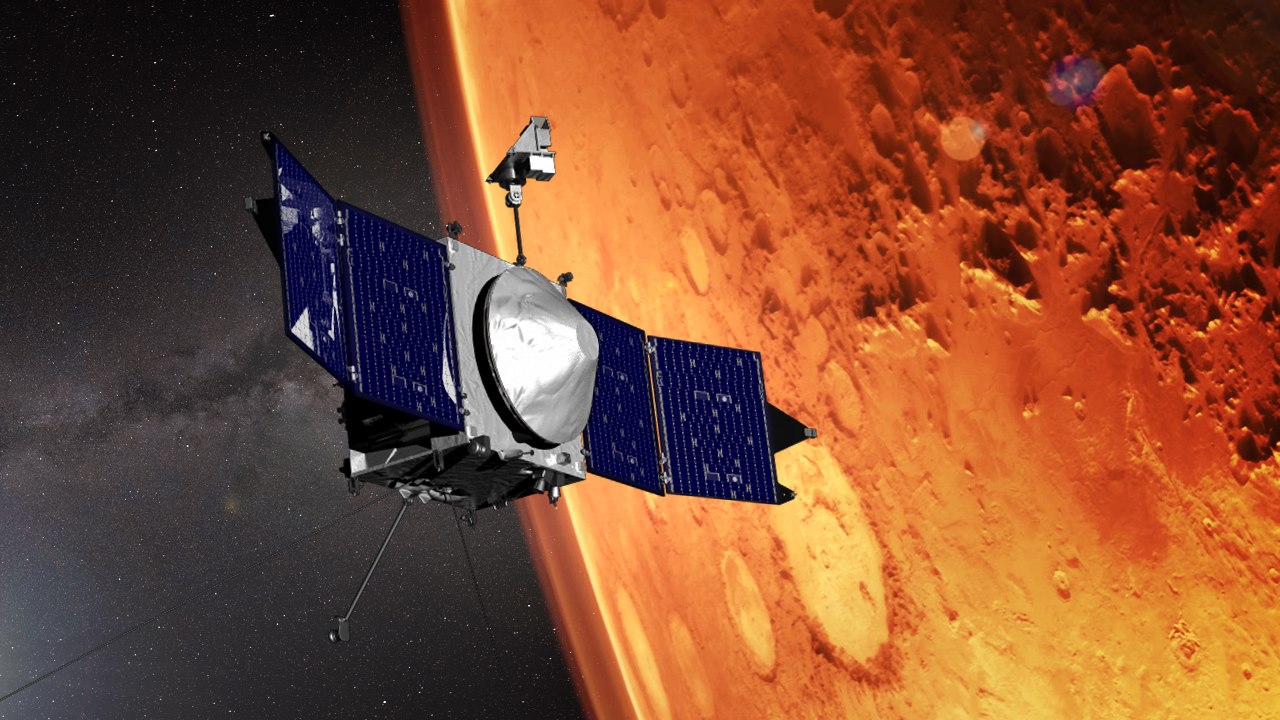This content has been archived. It may no longer be relevant

MAVEN scientists analyze data from the spacecraft and take three approaches to derive the history of Mars’ atmosphere:
— Use ratios of stable isotopes to determine the integrated loss to space
— Use observed changes in escape in response to changing energetic inputs to directly extrapolate back in time
— Model escape processes using current conditions and extrapolate models back in time
Taking these approaches allows MAVEN scientists to determine how various space weather events affect the upper atmosphere of Mars today and how they have contributed to its evolution over time. Capturing events of different magnitudes becomes more likely over time and contributes to producing more accurate model extrapolations back in time.
MAVEN data enable scientists to:
— Investigate atmospheric escape response to regular solar wind variations and to major events (solar flares, coronal mass ejections)
— Update an estimate of solar wind evolution
— Determine how solar energetic particles contribute to escape, and
— Estimate integrated historical loss to space
In order to accurately model Mars’ atmospheric evolution, MAVEN scientists not only consider major solar events that occur today, but they also use data from the Kepler Mission to model the output of Sun-like stars at various points in their evolution.
One complicating factor is that the tilt of Mars’ spin axis (obliquity) has varied between 15° and 45° over just the past 10 million years and between 0° and 70° over billions of years.
Article and photos courtesy of NASA’s MAVEN Mission to Mars
MAVEN data enable scientists to:
— Investigate atmospheric escape response to regular solar wind variations and to major events (solar flares, coronal mass ejections)
— Update an estimate of solar wind evolution
— Determine how solar energetic particles contribute to escape, and
— Estimate integrated historical loss to space
In order to accurately model Mars’ atmospheric evolution, MAVEN scientists not only consider major solar events that occur today, but they also use data from the Kepler Mission to model the output of Sun-like stars at various points in their evolution.
One complicating factor is that the tilt of Mars’ spin axis (obliquity) has varied between 15° and 45° over just the past 10 million years and between 0° and 70° over billions of years.
Article and photos courtesy of NASA’s MAVEN Mission to Mars
!['NASA scientists have determined that a primitive ocean on Mars held more water than Earth's Arctic Ocean and that the Red Planet has lost 87 percent of that water to space. Image Credit: @[54971236771:274:NASA - National Aeronautics and Space Administration]/ @[395013845897:274:NASA Goddard]'](https://scontent.xx.fbcdn.net/hphotos-xaf1/v/l/t1.0-0/q90/p160x160/12400996_10154217864187868_5897217810752342397_n.jpg?oh=8ca652e8a1b3386382bf0f9bf551badf&oe=57768C34)
!['The sweep of NASA Kepler mission’s search for small, habitable planets is shown in this artist's concept. The first planet smaller than Earth, Kepler-20e, was discovered in December 2011 orbiting a Sun-like star slightly cooler and smaller than our sun every six days. But it is scorching hot and unable to maintain an atmosphere or a liquid water ocean. Kepler-22b was announced in the same month, as the first planet in the habitable zone of a sun-like star, but is more than twice the size of Earth and therefore unlikely to have a solid surface. Kepler-186f was discovered in April 2014 and is the first Earth-size planet found in the habitable zone of a small, cool M dwarf about half the size and mass of our sun. Kepler-452b is the first near-Earth-Size planet in the habitable zone of a star very similar to the sun. (Image credit: @[338122981393:274:NASA Ames Research Center]/W. Stenzel)'](https://scontent.xx.fbcdn.net/hphotos-xal1/v/t1.0-0/p160x160/944880_10154217864327868_5195589446171268926_n.jpg?oh=9feb5bc5b7eb2ec26c78e8f897337f3c&oe=5785085C)
!['Changes in Tilt of Mars' Axis Modern-day Mars experiences cyclical changes in climate and, consequently, ice distribution. Unlike Earth, the obliquity (or tilt) of Mars changes substantially on timescales of hundreds of thousands to millions of years. At present day obliquity of about 25-degree tilt on Mars' rotational axis, ice is present in relatively modest quantities at the north and south poles (top left). This schematic shows that ice builds up near the equator at high obliquities (top right) and the poles grow larger at very low obliquities (bottom) (Image credit: @[8261258923:274:NASA Jet Propulsion Laboratory]-Caltech)'](https://scontent.xx.fbcdn.net/hphotos-xtf1/v/t1.0-0/p160x160/12472840_10154217864432868_8260851196427138673_n.jpg?oh=99878d73d1ea70fa48422b21c8931a0b&oe=578FFC2E)

